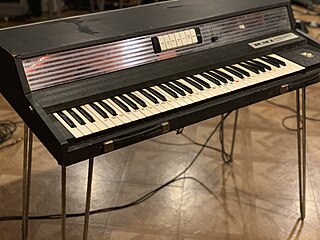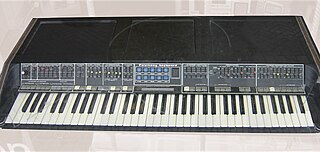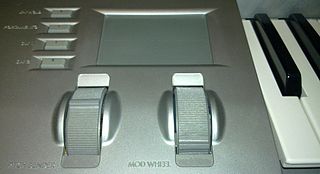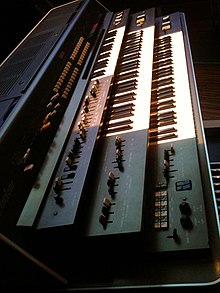
An analog synthesizer is a synthesizer that uses analog circuits and analog signals to generate sound electronically.

The Moog Taurus is a foot-operated analog synthesizer designed and manufactured by Moog Music. It was originally conceived as a part of the Constellation series of synthesizers. The initial Taurus I was manufactured from 1975 to 1981, followed by a less popular redesign, Taurus II, followed from 1981 to 1983. Instead of a conventional keyboard, the Taurus uses an organ-style pedal board similar to the pedal keyboard of a spinet organ. This control method was chosen because the Taurus was intended to be played by foot while the player's hands played one or more keyboards, although it was often used by guitarists. While the original Taurus featured its own synthesis engine, the Taurus II was essentially the same as the Moog Rogue. In 2010, Moog issued the Moog Taurus III which closely emulates the analog circuitry of the Taurus I, in addition to adding some modern features.
The Yamaha AN1x is a DSP-based analog modeling synthesizer, produced by Yamaha Corporation from 1997 to 1998, and was marketed as an "analog physical modelling control synthesizer".
Electone is the trademark used for electronic organs produced by Yamaha. With the exception of the top end performance models, most Electones are based on the design of the spinet electronic organ. Current models are completely digital and contain a variety of sounds, effects, and accompaniments, on top of the ability to store programming data onto memory devices.

The Realistic Concertmate MG-1 is an analog synthesizer manufactured by Moog Music in 1981 and sold by Radio Shack from 1982 to 1983 under their "Realistic" brand name. It was produced without some standard Moog features, such as pitch and modulation wheels, as a cost-cutting measure aimed at achieving a lower price for the consumer market. The synthesizer also featured a pair of pass-through RCA jacks, which allowed users to mix radio or records into the final live synthesized sound output.

The Moog synthesizer is a modular synthesizer invented by the American engineer Robert Moog in 1964. Moog's company, R. A. Moog Co., produced numerous models from 1965 to 1981, and again from 2014. It was the first commercial synthesizer and established the analog synthesizer concept.

Rocky Mount Instruments (RMI) was a subsidiary of the Allen Organ Company, based in Rocky Mount, North Carolina, active from 1966 to 1982. The company was formed to produce portable musical instruments, and manufactured several electronic pianos, harpsichords, and organs that used oscillators to create sound, instead of mechanical components like an electric piano.

The Polymoog is a hybrid polyphonic analog synthesizer that was manufactured by Moog Music from 1975 to 1980. The Polymoog was based on divide-down oscillator technology similar to electronic organs and string synthesizers of the time.
Polyphony is a property of musical instruments that means that they can play multiple independent melody lines simultaneously. Instruments featuring polyphony are said to be polyphonic. Instruments that are not capable of polyphony are monophonic or paraphonic.

The Korg MS2000 is a virtual analog synthesizer produced by the Japanese electronic musical instrument manufacturer Korg.

The Elka Synthex is a polyphonic analog synthesizer produced by Italian music instrument manufacturer Elka from 1981 to 1985.

The Yamaha CS30/CS30L is an analog keyboard synthesizer that was released in 1977. It is the top of the range in Yamaha's original line-up of monophonic synthesizers, others in the range being the CS5, CS10 and CS15. It features two voltage controlled oscillators (VCOs), two voltage controlled filters, two voltage controlled amplifiers (VCAs) and three envelope generators. It also sports a ring modulator and a voltage controlled low-frequency oscillator (LFO).

A synthesizer is an electronic musical instrument that generates audio signals. Synthesizers typically create sounds by generating waveforms through methods including subtractive synthesis, additive synthesis and frequency modulation synthesis. These sounds may be altered by components such as filters, which cut or boost frequencies; envelopes, which control articulation, or how notes begin and end; and low-frequency oscillators, which modulate parameters such as pitch, volume, or filter characteristics affecting timbre. Synthesizers are typically played with keyboards or controlled by sequencers, software or other instruments and may be synchronized to other equipment via MIDI.

The Korg PS-3300 is a polyphonic analog synthesizer, produced by Korg between 1977 and 1981.
The Roland MKS-80 Super Jupiter is a rack mount sound module version of the Roland Jupiter-6 and the Roland Jupiter-8 synthesizers. It is an 8-voice polyphonic analog synthesizer that was manufactured by Roland between 1984 and 1987. It is the only one of the MKS series of synthesizers to have analogue voltage-controlled oscillators (VCOs) instead of analogue digitally-controlled oscillators (DCOs). The voice architecture is almost identical to the Jupiter-6 synthesizer. The service manual states that "The module board of MKS-80 features the following in addition to that of JP-6, its brother module. 1) HPF. 2) Low boost circuit in the 2nd VCA. 3) DC supply current boost circuit (IC50)."

The CZ series is a family of low-cost phase distortion synthesizers produced by Casio in the mid-1980s. Eight models of CZ synthesizers were released: the CZ-101, CZ-230S, CZ-1000, CZ-2000S, CZ-2600S, CZ-3000, CZ-5000, and the CZ-1. Additionally, the home-keyboard model CT-6500 used 48 phase distortion presets from the CZ line. The CZ synthesizers' price at the time of their introduction made programmable synthesizers affordable enough to be purchased by garage bands. Yamaha soon introduced their own low-cost digital synthesizers, including the DX-21 (1985) and Yamaha DX100, in light of the CZ series' success.

The Korg Z1 is a physical modelling sound synthesiser released in 1997. Touted as a polyphonic Prophecy, the Z1 implements 13 synthesis types, all derived from the original OASYS synthesizer.

The Korg Minilogue is a polyphonic analog synthesizer released in 2016 by Korg. It offers users four-voice polyphony with two analog VCOs per-voice and was designed to be affordable. It was designed by Korg engineer and synthesizer designer Tatsuya Takahashi, who said "the concept of the Minilogue was to build an analog synthesizer that doesn't rely on the fame and success of an old synth".

The Yamaha DX21 is a digital controlled bi-timbral programmable digital FM synthesizer with a four operator synth voice generator which was released in 1985. It uses sine wave-based frequency modulation (FM) synthesis. It has two FM tone generators and a 32-voice random-access memory (RAM), 32 user voices and 128 read-only memory (ROM) factory preset sounds. As a programmable synth, it enables users to create their own unique synthesized tones and sound effects by using the algorithms and oscillators. The instrument weighs 8 kg (17.6 lbs). On its release, it sold for $795.
The history of home keyboards lies in mechanical musical instrument keyboards, electrified keyboards and 1960s and 1970s synthesizer technologies.
















